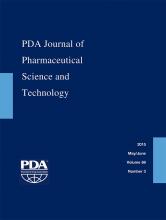Abstract
Syringe filling of high-concentration/viscosity monoclonal antibody formulations is a complex process that is not fully understood. This study, which builds on a previous investigation that used a bench-top syringe filling unit to examine formulation drying at the filling nozzle tip and subsequent nozzle clogging, further explores the impact of formulation–nozzle material interactions on formulation drying and nozzle clogging. Syringe-filling nozzles made of glass, stainless steel, or plastic (polypropylene, silicone, and Teflon®), which represent a full range of materials with hydrophilic and hydrophobic properties as quantified by contact angle measurements, were used to fill liquids of different viscosity, including a high-concentration monoclonal antibody formulation. Compared with hydrophilic nozzles, hydrophobic nozzles offered two unique features that discouraged formulation drying and nozzle clogging: (1) the liquid formulation is more likely to be withdrawn into the hydrophobic nozzle under the same suck-back conditions, and (2) the residual liquid film left on the nozzle wall when using high suck-back settings settles to form a liquid plug away from the hydrophobic nozzle tip. Making the tip of the nozzle hydrophobic (silicone-coating on glass and Teflon-coating stainless steel) could achieve the same suck-back performance as plastic nozzles. This study demonstrated that using hydrophobic nozzles are most effective in reducing the risk of nozzle clogging by drying of high-concentration monoclonal antibody formulation during extended nozzle idle time in a large-scale filling facility and environment.
LAY ABSTRACT: Syringe filling is a well-established manufacturing process and has been implemented by numerous contract manufacturing organizations and biopharmaceutical companies. However, its technical details and associated critical process parameters are rarely published. Information on high-concentration/viscosity formulation filling is particularly lacking. This study is the continuation of a previous investigation with a focus on understanding the impact of nozzle material on the suck-back function of liquid formulations. The findings identified the most critical parameter—nozzle material hydrophobicity—in alleviating formulation drying at the nozzle tip and eventually limiting the occurrence of nozzle clogging during the filling process. The outcomes of this study will benefit scientists and engineers who develop pre-filled syringe products by providing a better understanding of high-concentration formulation filling principles and challenges.
- Prefilled syringe
- High-concentration monoclonal antibody
- Suck-back
- Hydrophilic nozzles
- Hydrophobic nozzles
- Nozzle clogging
- © PDA, Inc. 2015
PDA members receive access to all articles published in the current year and previous volume year. Institutional subscribers received access to all content. Log in below to receive access to this article if you are either of these.
If you are neither or you are a PDA member trying to access an article outside of your membership license, then you must purchase access to this article (below). If you do not have a username or password for JPST, you will be required to create an account prior to purchasing.
Full issue PDFs are for PDA members only.
Note to pda.org users
The PDA and PDA bookstore websites (www.pda.org and www.pda.org/bookstore) are separate websites from the PDA JPST website. When you first join PDA, your initial UserID and Password are sent to HighWirePress to create your PDA JPST account. Subsequent UserrID and Password changes required at the PDA websites will not pass on to PDA JPST and vice versa. If you forget your PDA JPST UserID and/or Password, you can request help to retrieve UserID and reset Password below.






